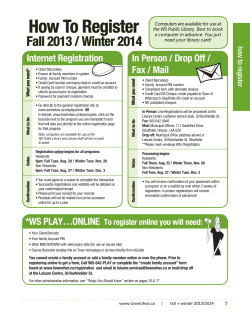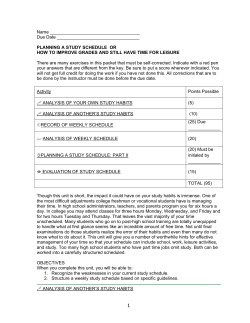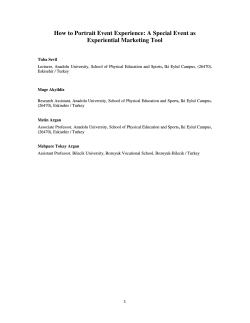
THE RELATIONSHIP AMONG LEISURE RESOURCEFULNESS AND
THE RELATIONSHIP AMONG LEISURE RESOURCEFULNESS AND RECREATION SPECIALIZATION AMONG A SAMPLE OF SENIOR ADULTS Jerry L. Ricciardo Associate Professor Eastern Michigan University Abstract Individual pursuits of hobbies among senior adults indicate a sustained interest in a recreation activity over an extended period of time. In this research the average number of years participating in a hobby is 42.8 years. Moreover, respondents indicated quite a diversity of recreational interests. Of the 172 respondents in the sample population, 127 respondents indicated that they had acquired a high recreation specialist status in his/her hobby participation. The Leisure Resourcefulness Scale (LRS) was used as a predictor variable to ascertain high recreation specialist or low recreation specialist status in his/her hobby participation. Following data reduction of the LRS, factor loadings identified two or three items in each of the five subscales of the LRS that best describe each subscale. However, only one of the five subscales served as a predictor variable of high recreation specialist status, and none of the five subscales identified low recreation specialist status. 1.0 Purpose of the Research The purpose of this research is to examine the Leisure Resourcefulness Scale (LRS) as a means of identifying individuals who are high or low in recreation specialization. Respondents’ recreation specialization status serves as an indicator of his/her leisure resourcefulness. High recreation specialization status indicates a considerable amount of sustained effort over time of energy, knowledge, resources, and dedication in a recreational pursuit. These individuals have the ability to identify and express a leisure need throughout life cycle stages. Presumably, individuals who are resourceful at leisure have a higher degree of personal capability in exhibiting an appropriate leisure lifestyle. 2.0 Objectives of the Research 1. To determine the reliability of the LRS. 2. To ascertain the dimensions of the subscales of the LRS. 3. To ascertain the dimensions of the scale items measuring recreation specialization. 4. To examine the relationship between leisure resourcefulness and recreation specialization. 3.0 Conceptual Background Leisure resourcefulness is a concept advanced by Rapoport and Rapoport (1975). Resourcefulness pertains first, to the individual’s ability to know and be able to make a meaningful life for him/herself within the realities of his/her own existence, and, second, being able to or knowing how to change those realities to effect an appropriate leisure lifestyle or one’s mode or manner of personal expression during nonwork time. The Rapports state that some individuals are more resourceful than others during their leisure time due to having more leisure resources of time, attitude, money, companions, knowledge, and equipment. The authors go on to state that leisure resourcefulness also varies with the personality of the person, one’s life cycle stage, and one’s adaptive abilities as changes occur during and throughout life cycle stages. As used in this research an individual’s leisure resourcefulness was measured using a series of five scales with a five-point Likert-type rating from strongly agree to strongly disagree. All scales but one consist of 10 items for a total of 49 items: leisure time, leisure knowledge, leisure attitude, leisure companions, and leisure equipment. The results of Cronbach’s Alpha test for reliability of each of the five subscales are provided in Table 1. Experience in a previous study with the LRS indicates both consistency and acceptability of reliability scores (Ricciardo 1999). 4.0 Recreational Specialization Recreation specialization research has been studied using different conceptual frameworks. Bricker and Kerstetter (2000) studied the concept from a place attachment perspective; Miller and Graefe (2000) examined the concept from different kinds of hunting activity; Graefe (1980) studied it from levels of participation. Ditton et al. (1992) reconceptualized recreation specialization for high and low recreation specialists from different perspectives of resource dependency, mediated interaction or needs for specific information concerning participation, and activity specific elements or perceived benefits of participation in the recreation experience. The initial conceptualization of recreation specialization was Bryan’s (1977) descriptive study of fishermen in the Proceedings of the 2004 Northeastern Recreation Research Symposium GTR-NE-326 397 Table 1.—Reliability Coefficients and Average Scores for the Leisure Resourcefulness Scale LRS Subscales Leisure Time Leisure Knowledge Leisure Attitude Leisure Companions Leisure Equipment No. of Items Standardized Item Alphas 10 10 10 09 10 .693 .819 .824 .896 .887 Average Scores1 3.33 3.27 2.41 2.62 2.35 s.d. .41 s.d. .45 s.d. .41 s.d. .64 s.d. .57 1Each scale item was measured as: 1=strongly agree, 2=agree, 3=neither agree nor disagree, 4=disagree, 5=strongly disagree northwest. Bryan stated that characteristic patterns of participation occur as fishermen “move through stages in their ‘fishing career’” from an occasional fisherman to a generalist, a technique specialist, and ultimately to a technique setting specialist. Each stage is characterized by increasing degrees of sophistication in fishing equipment, specific resource types, and changing membership in the fisherman’s social group; the fisherman moves from family participation to eventual membership in a group of fellow specialists. Bryan (1979) went on to apply the concept of specialization to a wide variety of outdoor recreation activities. In re-examining the concept of recreation specialization, Bryan (2000) stated, “I would emphasize a behavioral operational definition of the specialization continuum, length and degree of involvement in an activity. But integral to and concomitant with length and intensity of involvement are clusters of attitudes and values as to the sport’s meaning and its centrality to individual identity” (p. 19). Scott and Shafer (2001) concluded that Bryan believed: 1) recreation specialization exists in all activities; 2) activities differ in level of complexity; 3) the end product of specialization is an elite or privileged status in a leisure social world; and 4) the degree of specialization is a product of time, money, skill, and psychic commitment. Specialization occurs over time, that is, it is a developmental process as the participant moves along a continuum from an occasional participant with no or little commitment to the activity to a participant having a considerable investment of self and personal resources to become a specialist with the activity as a central life interest. Scott and Shafer (2001) further state from a review of multiple studies of specialization that, “Beyond the recognition that recreational specialization 398 includes a set of behaviors and attitudes, there remains little agreement about how precisely to characterize and measure the construct” (p. 326). This research identified recreation specialization as a “yes” or “no” variety, that is, high or low in specialization. The diversity and sophistication of both existing and current research of recreation specialization did not provide the basic conceptual framework needed to operationalize recreation specialization into a dichotomous variable. Bryan’s (1977) conceptualization of recreation specialization provided the framework for developing a measuring device to dichotomize respondents in this study into either high or low recreation specialists. A total of 15 items were provided in the data collection instrument to identify the respondent as either high or low in recreation specialization in his/her stated hobby based on Bryan’s conceptualization: the social group1, knowledge of the activity2, place of participation3, equipment4, commitment5, and stage of development6. The respondent was asked to either agree or disagree with each item. 1 I mostly participate in this activity with my family. I mostly participate in this activity with others who are as good as I am. 2 I know more about this activity than most people. 2 I have taught this activity to others (family, friends, interested persons). 3 I require special places (a room, area, setting) to enjoy this activity. 1 4 I require specialized equipment to participate in this activity. Proceedings of the 2004 Northeastern Recreation Research Symposium GTR-NE-326 5 I go on vacations just to participate in this activity. I have read a lot of books about this activity. 5 This activity is an important part of my life. 5 I receive a great deal of satisfaction from this activity. 5 I spend a good amount of time and money to participate in this activity. 6 I have received awards or certificates for my skills in this activity. 5 6I 6I have a lot to learn about this activity. am a beginner in this activity. 5.0 Data Collection & Sample Data were collected by students enrolled in recreation courses by way of a self-administered questionnaire. Each student was provided five self-administered questionnaires. Students were instructed to provide one questionnaire per household to an adult 65 years of age or older who may be a family member, relative, friend, or acquaintance. The students are commuters who are residents of a major metropolitan area. The sample population consists of 172 respondents. 6.0 Results 6.1 Sample Population Eighty-six percent of the sample respondents are Caucasian and approximately six percent are African American. The average age is 68 with an approximately equal number of males and females. Sixty percent of the respondents are married and 57 percent live at home with their spouse. One-third of the sample has earned a college or advanced degree. Fifty-five percent have either graduated from high school, a tech school, or experienced some college. Forty percent of the respondents have an income of less than $40,000 and 36 percent have incomes between $40,000 and $70,000 while 18 percent have incomes greater than $70,000. Fifty percent of the sample population report having one or two sources of income in their retirement and 50 percent experience three or four sources of income. Fifty-eight percent of the sample population worked at their occupations for 30 or more years. Seventy-two percent of the respondents report their present health as excellent or good, and 86 percent of the respondents state that they have their own transportation. 6.2 Hobbies The question concerning hobby participation asked: “What leisure activity/hobby have you been participating in the longest (for example, you may have been fishing or collecting since childhood, play a musical instrument, play cards)?” Sporting activities shows the highest number of participants (47) with an average number of years of participation of 40.3 years (Table 2). Thirty respondents participate in crafts averaging 50.6 years of participation. This is followed by participants in table games averaging 41.0 years of participation followed by those who fish/hunt with an average of 60.9 years of participation. The average number of years participating in a hobby is 42.8 years. Hobbies that ranked highest in average years of participation are baking/cooking (67.0 years) followed by fishing/hunting (60.9), animal husbandry (59.0), playing a musical instrument (58.5), and research/study (57.0). The highest maximum number of years reported in hobby participation is 86 years in crafts followed by 79 years in fishing/hunting, 73 years in baking/cooking, and 69 years in restoration of cars or furniture. The average minimum number of years participating is 28.5 years and the average maximum number of years participating is 56.3 years. Sixty-one percent of the respondents reported that either a parent (57 or 33.1%) or a friend (48 or 27.9%) got them started in their chosen hobby. 6.3 Leisure Resourcefulness Five subscales are used to measure leisure resourcefulness: leisure time, leisure knowledge, leisure attitude, leisure companions, and leisure equipment. Each of the five subscales was factor analyzed using the principal components method with varimax rotation to determine the dimensionality of the scales. Statistics from the five subscale analyses indicate that each subscale is unidimensional. The subscales were again factor analyzed but with no rotations. The results of these analyses are provided in Table 3. Of the 10 items in each subscale, the factor loadings indicate that only two or three factors load highest for each subscale. The factors scores were saved and used as independent or predictor variables of high or low specialist status in hobby participation. 6.4 Recreation Specialization Cronbach’s Alpha test for reliability for the recreation specialization scale is .602, the lower limit of acceptability. These scale items were factor analyzed using principal components analysis with multiple rotations. Proceedings of the 2004 Northeastern Recreation Research Symposium GTR-NE-326 399 Table 2.—Hobby or Recreation Activity Participation Hobby N Animal husbandry Baking/Cooking Biking/Cycling Camping/Hiking/Boating Collecting1 Computers Crafts2 Drawing/Painting Fish/Hunt Gardening Go to Bar/Church/Sports Horseback Ride Play Musical Instrument3 Read/Watch TV Research/Study4 Restoration5 Shopping/Go to Flea Markets Sports6 Square Dancing Table Games7 Traveling Volunteering Walking Missing Totals % 1 3 2 4 8 2 30 4 15 5 3 1 3 6 3 6 4 47 1 16 2 1 4 1 0.6 1.7 1.2 2.3 4.7 1.2 17.4 2.3 8.7 2.9 1.7 0.6 1.7 3.5 1.7 3.5 2.3 27.3 0.6 9.3 1.2 0.6 2.3 0.6 172 100.0 Years Participating Average 59.0 67.0 36.0 46.7 40.1 1.5 50.6 49.7 60.9 43.6 36.5 45.0 58.5 47.0 57.0 48.6 33.0 40.3 md 41.0 8.5 40.0 32.3 Min 59 61 36 25 15 1 11 19 43 22 26 45 56 36 40 40 10 11 md 2 7 40 22 Max 59 73 36 65 65 2 86 65 79 68 47 45 61 66 66 69 61 64 md 68 10 40 45 1Antiques, cards, coins, stamps, toys ceramics, crocheting, knitting, model airplanes, photography, quilting, rug hooking, stitching, wood carving, wood work 3Piano, cello 4Covered bridges, geographic areas, inventing 5Cars, furniture 6Billiards, bowling, cycling, exercise, golf, ice hockey, jogging, racket ball, shooting, skiing, softball, swimming, triathalons, weight training 7Bingo, bridge, card playing, chess, gambling, crosswords, jigsaw puzzles 2Sewing, Results of the factor analysis are provided in Table 4. Three factors identify the high recreation specialist: recreation equipment, knowledge of the activity, and stage of development. Two items load highest on the low recreation specialist. These factors are identified with stage of development. This research identified 127 or 73.8 percent of the respondents as high recreation specialists, that is, the respondent agreed with all three of the high recreation specialist factors. Thirty-nine or 22.7 percent of the respondents agreed with the two scale items identifying low recreation specialists (missing data = 6 or 3.5 percent). 400 6.5 The Relationship Between Recreation Specialization and the LRS Subscales The factor scores for recreation specialization were used as dependent variables, and the factor scores for the LRS subscales were used as independent variables. Multiple linear regression indicated significance for the subscale of leisure equipment as a predictor variable to identify respondents who are high recreation specialists (Table 5). However, the R2 is very low, only .082 or 8 percent and with low value correlation coefficients. No variables in the LRS subscales identified the low recreation specialist. Proceedings of the 2004 Northeastern Recreation Research Symposium GTR-NE-326 Table 3.—Factor Analysis Results for the Leisure Resourcefulness Scale: Leisure Time, Leisure Knowledge, Leisure Attitude, Leisure Companions, and Leisure Equipment Leisure Time Leisure time is for enjoyment. Leisure time is doing things I like to do. I value my free time. Summary Statistics Factor Eigenvalue % of Variance 1 3.136 31.356 2 1.444 14.445 3 1.267 12.669 Leisure Knowledge I know a lot of things to do in leisure. I know leisure opportunities when I see them. I know places to go for leisure. Summary Statistics Factor Eigenvalue % of Variance 1 4.096 40.957 2 1.196 11.959 3 0.839 8.387 Leisure Attitude Leisure is a necessary part of my life. I know why leisure is important to me. Summary Statistics 0.760 0.732 0.716 Cumulative % 31.356 45.801 58.469 0.753 0.747 0.738 Cumulative % 40.957 52.916 61.302 0.703 0.700 Factor Eigenvalue % of Variance Cumulative % 1 4.124 41.243 41.243 2 1.015 10.153 51.396 Leisure Companions I have friends to do most anything I want to do in leisure. My friends know a lot of leisure activities. Summary Statistics Factor Eigenvalue % of Variance 1 4.927 54.746 2 0.807 8.964 Leisure Equipment I know how to use my leisure equipment I know where to purchase equipment I need. Summary Statistics Factor Eigenvalue % of Variance 1 5.271 52.709 2 1.229 12.291 0.793 0.750 Cumulative % 54.746 63.709 0.843 0.823 Cumulative % 52.709 64.999 Proceedings of the 2004 Northeastern Recreation Research Symposium GTR-NE-326 401 Table 4.—Factor Analysis Results for the Recreation Specialization Scale High Recreation Specialist (n = 127) I require specialized equipment to participate in this activity. I have taught this activity to others. I have received awards or certificates for my skills in this activity Low Recreation Specialist (n = 39) I am a beginner in this activity. I just started participating in this activity. 0.625 0.525 0.504 0.723 0.671 Summary Statistics Factor 1 2 Eigenvalue 2.516 1.841 % of Variance 16.775 12.275 Cumulative % 16.775 29.050 Table 5.—Summary Statistics of Multiple Regression Analysis of Respondents Who Are High Recreation Specialists or Low Recreation Specialists and the Leisure Resourcefulness Scales (LRS) LRS as Independent Variables Beta High Recreation Specialist (n=127) Leisure Time .008 Leisure Knowledge .093 Leisure Attitude -.048 Leisure Companions .066 Leisure Equipment .220 2 R =.082 Low Recreation Specialist (n=39) Leisure Time -.017 Leisure Knowledge -.044 Leisure Attitude -.004 Leisure Companions .163 Leisure Equipment -.145 R2=.035 Correlation Coefficients Sig. Zero-Order Partial Part .082 .821 -.376 .715 2.272 .935 .413 .707 .476 .025 .092 .199 .146 .160 .270 .007 .069 -.032 .060 .189 .007 .066 -.030 .058 .184 -.165 -.376 -.033 1.734 -1.461 .869 .707 .974 .085 .146 -.036 -.061 -.039 .089 -.116 -.014 -.032 -.003 .145 -.123 -.014 -.031 -.003 .144 -.121 t 7.0 Conclusions Sample respondents in this research represent a convenience sample, that is, students collecting data among family, relatives, friends, and acquaintances. The socio-demographic characteristics of the sample population closely approximate those provided by U. S. Census Bureau data for the State of Michigan in ethnicity, income, education, and occupation. The sample data provide some interesting insights into hobbies over the respondents’ life span as seen in 402 Table 2. A wide range of classifications of hobbies are possible: indoors-outdoors, active-passive, expressivenonexpressive, solitary-nonsolitary, equipment specialized-nonspecialized, expensive-inexpensive, formalinformal, readily available-distant, skilled-unskilled, public-private, and resource dependent-resource independent. The influence of the parents or friends in getting the respondent started in the activity indicates the importance of the immediate social group for leisure Proceedings of the 2004 Northeastern Recreation Research Symposium GTR-NE-326 continuity or the transfer of leisure knowledge and skills from one’s earlier and formative years to one’s adult years. Average scores on the LRS subscales (Table 1) indicate that respondents neither strongly agreed nor agreed with statements in the LRS subscales of leisure time and leisure knowledge (average scores of 3.33 and 3.27 respectively). The implication is that learning about leisure is hit-or-miss, or sometimes successful and sometimes not. Given that individuals pursue careers of work with such intensity as to devote their youthful years and personal and societal resources to acquire work skills, careers at leisure are given token consideration in our society. Yet with an increasing life span (average of 89 years of age by 2050) individuals will have several decades after retirement with huge blocks of time available for leisure careers, nonwork opportunities, and the pursuit of appropriate leisure lifestyles unencumbered by the demands of work organizations. Leisure education would assist in empowering these individuals to command appropriate leisure lifestyles. Bryan, H. (1979). Conflict in the great outdoors. Sociological Studies No. 4. University of Alabama: Bureau of Public Administration. Bryan, H. (2000). Recreational specialization revisited. Journal of Leisure Research, 32 (1), 18-21. Ditton, R. B., Loomis, D. K., and Choi, C. (1992). Recreation specialization: Re-conceptualization from a social worlds perspective. Journal of Leisure Research, 24 (1), 33-51. Graefe, A. R. (1980). The relationship between level of participation and selected aspects of specialization in recreational fishing. Unpublished doctoral dissertation, Texas A&M University, College Station, Texas. Miller, C. A. and Graefe, A. R. (2000). Degree and range of specialization across related hunting activities. Leisure Sciences: 195-204. Specialized leisure equipment and the transfer of and/or demonstration of specialized knowledge of a specific recreation activity (Table 4) distinguish the high recreation specialist from the low recreation specialist. The commitment of individual resources of time, space, money, effort, equipment, and enthusiasm to pursue a specific recreation activity for four to five decades (Table 2) underlines the effort individuals will exert to achieve life satisfaction and a leisure identity through participation and recognition in a recreation activity. Rapoport, R. & Rapoport, R. N. (1975). Leisure and the family life cycle. Boston: Routledge and Kegan Paul. 8.0 Citations Scott, D. and Shafer, C. S. (2001). Recreational specialization: A critical look at the construct. Journal of Leisure Research, 33(3), 319-343. Bryan, H. (1977). Leisure value system and recreational specialization: The case of trout fishermen. Journal of Leisure Research, 9, 174-187. Ricciardo, J. L. (1999). Intensity and extensity of recreation participation in light of the mean scores on the leisure resourcefulness scale. In G. Kyle (Comp., Ed.), Proceedings of the 1999 Northeastern Recreation Research Symposium (Gen. Tech. Rep. NE-269, pp. 304-308). Newtown Square, PA: USDA, Forest Service, Northeastern Research Station. Proceedings of the 2004 Northeastern Recreation Research Symposium GTR-NE-326 403
© Copyright 2025









